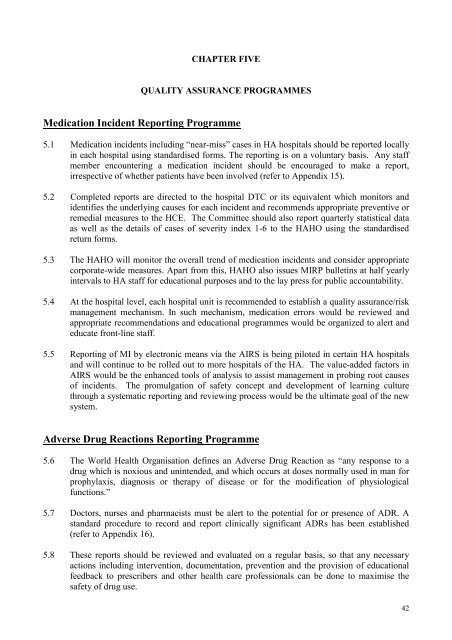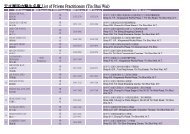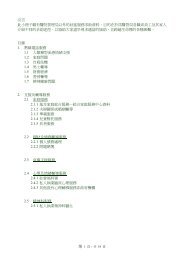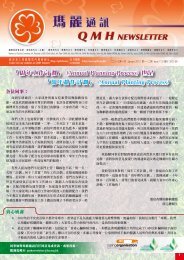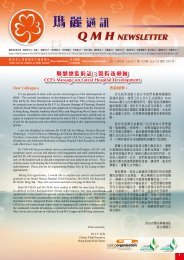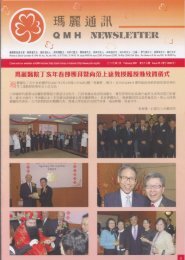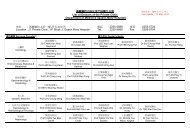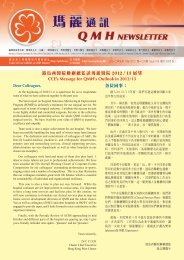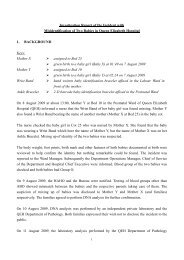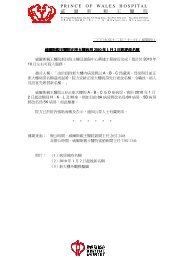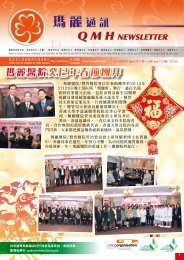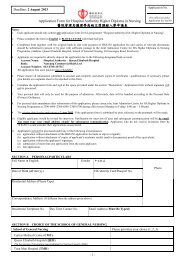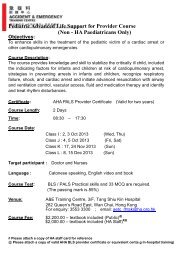2005 Edition Report on Drug Administration Procedure & Practices ...
2005 Edition Report on Drug Administration Procedure & Practices ...
2005 Edition Report on Drug Administration Procedure & Practices ...
You also want an ePaper? Increase the reach of your titles
YUMPU automatically turns print PDFs into web optimized ePapers that Google loves.
CHAPTER FIVEQUALITY ASSURANCE PROGRAMMESMedicati<strong>on</strong> Incident <str<strong>on</strong>g>Report</str<strong>on</strong>g>ing Programme5.1 Medicati<strong>on</strong> incidents including “near-miss” cases in HA hospitals should be reported locallyin each hospital using standardised forms. The reporting is <strong>on</strong> a voluntary basis. Any staffmember encountering a medicati<strong>on</strong> incident should be encouraged to make a report,irrespective of whether patients have been involved (refer to Appendix 15).5.2 Completed reports are directed to the hospital DTC or its equivalent which m<strong>on</strong>itors andidentifies the underlying causes for each incident and recommends appropriate preventive orremedial measures to the HCE. The Committee should also report quarterly statistical dataas well as the details of cases of severity index 1-6 to the HAHO using the standardisedreturn forms.5.3 The HAHO will m<strong>on</strong>itor the overall trend of medicati<strong>on</strong> incidents and c<strong>on</strong>sider appropriatecorporate-wide measures. Apart from this, HAHO also issues MIRP bulletins at half yearlyintervals to HA staff for educati<strong>on</strong>al purposes and to the lay press for public accountability.5.4 At the hospital level, each hospital unit is recommended to establish a quality assurance/riskmanagement mechanism. In such mechanism, medicati<strong>on</strong> errors would be reviewed andappropriate recommendati<strong>on</strong>s and educati<strong>on</strong>al programmes would be organized to alert andeducate fr<strong>on</strong>t-line staff.5.5 <str<strong>on</strong>g>Report</str<strong>on</strong>g>ing of MI by electr<strong>on</strong>ic means via the AIRS is being piloted in certain HA hospitalsand will c<strong>on</strong>tinue to be rolled out to more hospitals of the HA. The value-added factors inAIRS would be the enhanced tools of analysis to assist management in probing root causesof incidents. The promulgati<strong>on</strong> of safety c<strong>on</strong>cept and development of learning culturethrough a systematic reporting and reviewing process would be the ultimate goal of the newsystem.Adverse <strong>Drug</strong> Reacti<strong>on</strong>s <str<strong>on</strong>g>Report</str<strong>on</strong>g>ing Programme5.6 The World Health Organisati<strong>on</strong> defines an Adverse <strong>Drug</strong> Reacti<strong>on</strong> as “any resp<strong>on</strong>se to adrug which is noxious and unintended, and which occurs at doses normally used in man forprophylaxis, diagnosis or therapy of disease or for the modificati<strong>on</strong> of physiologicalfuncti<strong>on</strong>s.”5.7 Doctors, nurses and pharmacists must be alert to the potential for or presence of ADR. Astandard procedure to record and report clinically significant ADRs has been established(refer to Appendix 16).5.8 These reports should be reviewed and evaluated <strong>on</strong> a regular basis, so that any necessaryacti<strong>on</strong>s including interventi<strong>on</strong>, documentati<strong>on</strong>, preventi<strong>on</strong> and the provisi<strong>on</strong> of educati<strong>on</strong>alfeedback to prescribers and other health care professi<strong>on</strong>als can be d<strong>on</strong>e to maximise thesafety of drug use.42


